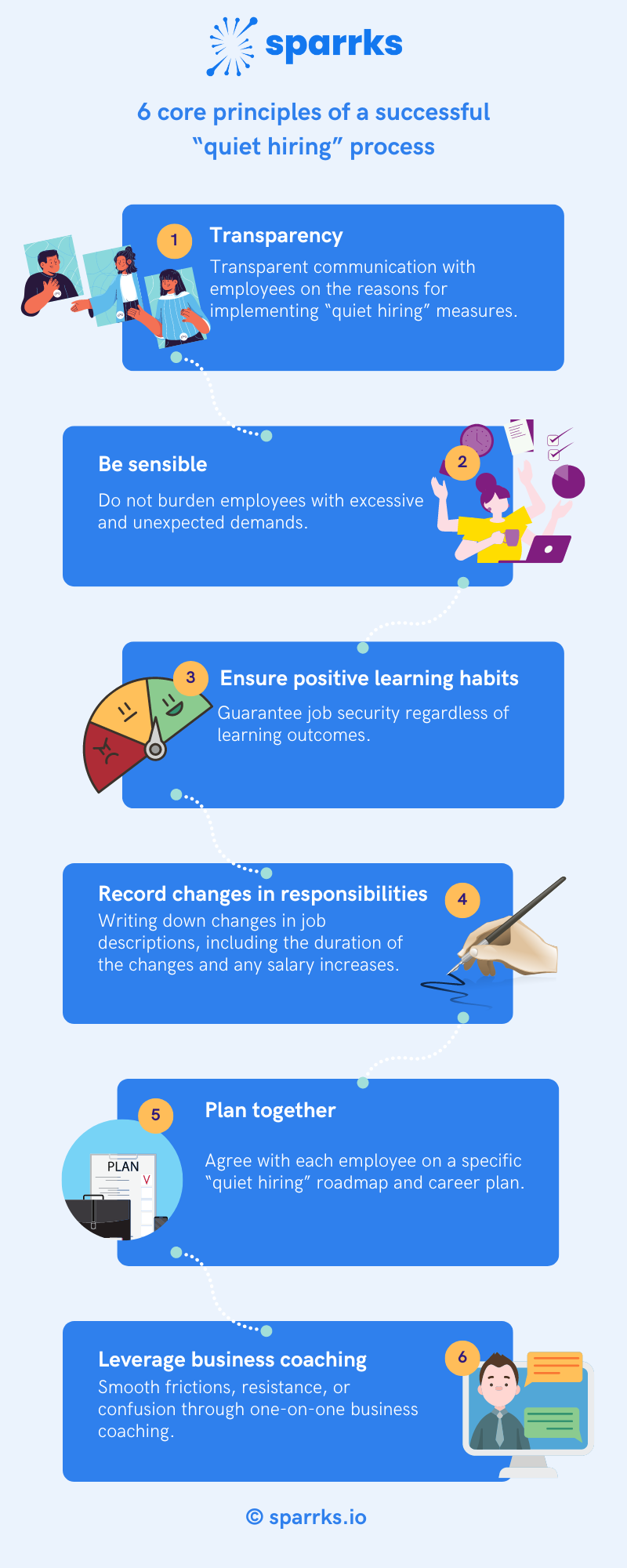"Quiet hiring" is an English-language term used in human resource management. It refers to the targeted upskilling of professionals and the personal skills of a company's employees. The goal is to get the best out of employees and, in a sense, turn them into new employees.
In this article, you will learn in more detail what "quiet hiring" means, why the term is currently enjoying increasing popularity, and whether there is more behind it than just a new name for a well-known concept. We'll also look at the steps needed for a successful "quiet hiring" process. Finally, you'll learn about the challenges of "quiet hiring" and how to deal with them to take advantage of this new HR trend concept.

What does "quiet hiring" mean?
The conceptual history of "quiet hiring" dates back to 2018. That year, "quiet quitting" was on everyone's lips. Quiet Quitting refers to an attitude of employees to no longer make an effort at work but only to perform duty according to the rules - in other words, to have quit the job inwardly. On the other hand, "quiet hiring" is a different phenomenon. But because both phenomena involve something that happens in secret, the two phenomena are connected.
But what exactly does "quiet hiring" mean? First and foremost, it's a win-win situation for employees and companies. "Quiet hiring" involves the targeted development of relevant and selected skills in personal and professional areas. In this way, the company gets better employees without hiring new ones. The employees benefit from the fact that they can grow professionally and personally and take on new roles and responsibilities.
Why is this topic becoming more and more popular in personnel development?
As "quiet hiring" is an attractive long-term strategy to increase the skills and also the satisfaction of employees, the concept is currently enjoying increasing popularity in personnel development. "Quiet hiring" is a creative way to expand the pool of candidates for leadership positions and enrich teams with enhanced competencies. It makes new hires much less relevant and decreases costs.

For HR staff, "quiet hiring" is additionally very interesting because it increases the flexibility of personnel management. Promoting individual employees in a targeted and efficient manner allows companies to fill new roles and positions promptly. That includes replacing gaps left by surprise terminations. "Quiet hiring" can help overcome other time-critical challenges, such as those that often arise in project-based work that requires specific skills on a selective basis.
"Quiet hiring" is a sensible approach when employees do not achieve corporate goals. Since managers avoid hiring new employees in advance, existing employees have second chances to prove themselves. Also, underperforming employees at a new position allocated to them through "quiet hiring" can return to their original role.
"Quiet hiring" has become relevant in HR because it increases (above all) employee retention and motivation. If employees get the chance to improve their personal and professional skills, they often feel valued and recognize their opportunities for further development within the company. In this way, termination rates fall while sustained productivity increases.
Is "quiet hiring" more than just a new name for a well-known concept?
Before we look at how you can successfully implement the "quiet hiring" method in your company, you may wonder whether there is more behind the nice name than the old familiar concept of personnel development.
At first glance, it seems as if "quiet hiring" is just another buzzword - after all, HR management and upskilling have been around for quite some time. Of course, "quiet hiring" does not reinvent the wheel, and you will not find a radically new idea behind the term. However, the new concept points to a new and welcoming development: companies are increasingly tackling professional and personal development.
Accordingly, "quiet hiring" may not appear to be a new concept at first glance. The term itself stands for much more than just targeted personnel development. It stands for the fact that individual development, growth, and employee retention are becoming increasingly crucial in the working world. For more and more employees, furthering education is of enormous importance.
For this reason, do not dismiss "quiet hiring" as just another trendy Anglicism. Instead, look closely at the shift in values that the term represents.
"Many HR managers are already into quiet hiring - they're just not aware of it most of the time."
Dr. Nicolas Stephan, Managing Director Sparrks, managerSeminare
Individual steps in building a successful "quiet hiring" process
HR managers should implement several core principles to build a successful "quiet hiring" process. Also, each "quiet hiring" process should suit the company and, within the company, individual employees.
- Transparent communication on the reasons for "quiet hiring" measures. Managers should rely on personal decisions from employees when it concerns employee learning measures. Instructions from management without the appropriate motivation of employees are more likely to jeopardize learning successes than to benefit them.
- Do not throw employees in at the deep end and discourage or overwhelm them with excessive and unexpected demands. Instead, further development measures should sensibly build on and complement existing qualifications.
- To ensure the best possible learning atmosphere, it is also essential to guarantee job security, regardless of learning outcomes. Otherwise, uncertainty and unnecessary pressure threaten to jeopardize learning success.
- Transparent communication also includes always putting changes in employees' job descriptions in writing. That means not only new responsibilities and roles but also the duration of the changes and any salary increases.
- Then create a Quiet Hiring plan with each employee - and take the opportunity to also agree on a career plan together. This way, your employees can directly see the long-term benefits of the training and feel additionally motivated by the clear goals in front of them.
- Find measures that guarantee the expansion of skills according to individual wishes and learning modes. Sensible measures are one-on-one coaching sessions such as Sparrks Coaching. With Sparrks Coaching, employees benefit from a coach explicitly selected for them, with whom they work on specific topics matching their development needs. Within just a few sessions, employees achieve outstanding progress that has a lasting, positive impact on them and the whole company.

Challenges in "quiet hiring
To benefit from "quiet hiring" tactics, managers should consider several challenges.
In particular, employee skepticism about new requirements and further development measures can prove problematic and prevent success through Quiet Hiring. To avoid this, transparency in communicating the cause, implementation, and goals of "quiet hiring" is crucial. In this way, managers can eliminate ambiguities and emphasize the added value of the planned further development measures.
Also, note that "quiet hiring" is not a panacea and is only possible within a particular framework. The goal of "quiet hiring" is not to have your employees learn entirely new skills. Your employees should not feel overwhelmed at all!
Furthermore, "quiet hiring" does not make new hires completely obsolete. After all, you need new employees to grow; you do not want employees to feel crushed by demands and workload.
But if you keep these aspects in mind, nothing will stand in the way of successful "quiet hiring"!
Conclusion
"Quiet hiring" is a new term in HR that takes the familiar concept of personnel development and links it to currently relevant values in the world of work. Also, it describes upskilling, coaching, and other measures taken in consultation with the employees to be effective. Employees should not experience overwork or increased stress. Used sensibly, "quiet hiring" can be a highly effective way to promote employees and company prosperity!

FAQ: Quiet hiring
What are some examples of "quiet hiring"?
Quiet hiring examples include scenarios when the employer starts assigning new tasks and responsibilities to an employee outside the job description, assigning new tasks to an employee with the vague promise of moving them to a new employee who would fill out a vacancy, telling employees to go through a skill development program, training, or workshop on the premises that it will improve their careers, transfer of employees to other departments on the claim of needing expertise in those departments, and employees receiving more benefits from the company once they take on more responsibilities and tasks.
Is quiet hiring a new trend?
"Quiet hiring" is a new trend, one of the nine main work trends for 2023, according to Gartner . "Quiet hiring" had a boost in late 2022 as a response to "quiet quitting" among many employees and across markets. Companies deploy "quiet hiring" as a tactic to retain talent.
Is "quiet hiring" legal?
Unlike "quiet firing," "quiet hiring" is legal and ethical when implemented responsibly.




